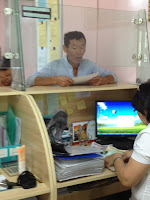A couple of days late with this post...busy, busy, busy J
 |
| Member service at Altandaalgaa SCC |
number of credit unions in Mongolia declare bankruptcy, and it is soon clear why. We are peppered with questions about inflation, governance, membership engagement and board engagement by lunch both Trudy and I are looking rather frazzled and our poor interpreter is taking off her glasses and rubbing her eyes wearily.
When we start to talk about strategic plans the executive director pipes up. She would like to expand into the ger (pronounced gar) district. The ger district starts only 4 blocks from where we sit. On one side of the road are multi story apartment buildings on the other is a laborite of makeshift single family homes. Spread out for miles, traditionally this was where transient Mongolians would set up their ger when they came to UB. In 2002 the Mongolian government started to grant property ownership rights to all of its citizens, prior to this all land was owned by the government. Apartments were deeded to the occupant at the time and all other people were allocated a small amount of land depending on where they claimed it.
 |
| Ger district |
district is actually owned by the occupants. Most of the gers have been removed and replaced by make shift homes. Wooden shacks and small square brick homes each with a fence are butted up against each other in no particular order. Gravel roads snake in all directions and sign posts are nonexistent. Poverty and alcoholism are rampant in this area.
For
a myriad of reasons there has been a migration to UB over the last several
years, first there was the move to a market economy which caused wages to plummet
and unemployment to sky rocket, then in 2010 a dzud struck (a really bad winter
that killed millions of animals and left thousand of rural families struggling
to survive). Traditionally Mongolians are nomadic, so they move, when the
seasons change, when times are tough, when the grass grows greener, they pack
up their gers and hit the road. One argument is that problems arise when they
quit moving. Many arrive in UB with the
expectation that they will be able to obtain work. While the unemployment numbers for Mongolia
are definitely trending downwards there is still a significant % of the
population that is not able to find work. Add to this the vodka legacy left over from
the Soviet Union and you have issues.
It
is against this backdrop that we visit the Tsolmon-Ireedui Foundation (like them on facebook for more inof at - Tsolmon-Ireedui Foundation). A member of the credit union Chimgee Tsolmon
has taken out a loan to expand her home to accommodate a
daycare/orphanage. Unable to obtain
financing at the banks she is passionate about her cause. Her goals are simple, to provide a safe and
affordable (free if required) place for parents (often single) to leave their
children so that they are able to find productive work that can improve the
quality of live for their families. When we ask Chimgee what her dream is she
tells us that it is really quite simple.
She believes that if these children are provided with adequate food and
water and a safe environment they will then be able to study instead of worrying
about how to survive. Provided with the
opportunity to study she believes that the children will then have a chance to
succeed, to go onto university.
As
we leave the orphanage I am struck again with the similarity between Canada and
Mongolia,. Unfortunately we have the
same issues at home. I could very well
be standing “on reserve”. This makes me
ask myself, if these credit unions who are struggling to survive with so much
less than we have, are working towards improving conditions for those who need
it most...what are we doing, or perhaps more to the point why are we not doing
more?

























